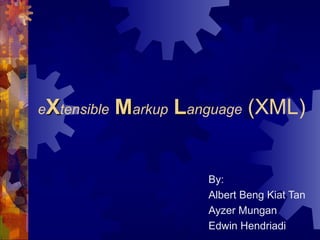
Xml 215-presentation
- 1. eXtensible Markup Language (XML) By: Albert Beng Kiat Tan Ayzer Mungan Edwin Hendriadi
- 2. Outline of Presentation Introduction Comparison between XML and HTML XML Syntax XML Queries and Mediators Challenges Summary
- 3. What is XML? eXtensible Markup Language Markup language for documents containing structured information Defined by four specifications: XML, the Extensible Markup Language XLL, the Extensible Linking Language XSL, the Extensible Style Language XUA, the XML User Agent
- 4. XML…. Based on Standard Generalized Markup Language (SGML) Version 1.0 introduced by World Wide Web Consortium (W3C) in 1998 Bridge for data exchange on the Web
- 5. Comparisons XML HTML Extensible set of tags Fixed set of tags Content orientated Presentation oriented Standard Data No data validation infrastructure capabilities Allows multiple Single presentation output forms
- 6. Authoring XML Elements An XML element is made up of a start tag, an end tag, and data in between. Example: <director> Matthew Dunn </director> Example of another element with the same value: <actor> Matthew Dunn </actor> XML tags are case-sensitive: <CITY> <City> <city> XML can abbreviate empty elements, for example: <married> </married> can be abbreviated to <married/>
- 7. Authoring XML Elements (cont’d) An attribute is a name-value pair separated by an equal sign (=). Example: <City ZIP=“94608”> Emeryville </City> Attributes are used to attach additional, secondary information to an element.
- 8. Authoring XML Documents A basic XML document is an XML element that can, but might not, include nested XML elements. Example: <books> <book isbn=“123”> <title> Second Chance </title> <author> Matthew Dunn </author> </book> </books>
- 9. XML Data Model: Example <BOOKS> <book id=“123” BOOKS loc=“library”> book loc=“library” article <author>Hull</author> <title>California</title> ref 123 555 <year> 1995 </year> </book> author year author title <article id=“555” title ref=“123”> <author>Su</author> Hull 1995 Su Purdue <title> Purdue</title> California </article> </BOOKS>
- 10. Authoring XML Documents (cont’d) Authoring guidelines: All elements must have an end tag. All elements must be cleanly nested (overlapping elements are not allowed). All attribute values must be enclosed in quotation marks. Each document must have a unique first element, the root node.
- 11. Authoring XML Data Islands A data island is an XML document that exists within an HTML page. The <XML> element marks the beginning of the data island, and its ID attribute provides a name that you can use to reference the data island.
- 12. Authoring XML Data Islands (cont’d) Example: <XML ID=“XMLID”> <customer> <name> Mark Hanson </name> <custID> 29085 </custID> </customer> </XML>
- 13. Document Type Definitions (DTD) An XML document may have an optional DTD. DTD serves as grammar for the underlying XML document, and it is part of XML language. DTDs are somewhat unsatisfactory, but no consensus exists so far beyond the basic DTDs. DTD has the form: <!DOCTYPE name [markupdeclaration]>
- 14. DTD (cont’d) Consider an XML document: <db><person><name>Alan</name> <age>42</age> <email>agb@usa.net </email> </person> <person>………</person> ………. </db>
- 15. DTD (cont’d) DTD for it might be: <!DOCTYPE db [ <!ELEMENT db (person*)> <!ELEMENT person (name, age, email)> <!ELEMENT name (#PCDATA)> <!ELEMENT age (#PCDATA)> <!ELEMENT email (#PCDATA)> ]>
- 16. DTD (cont’d) Occurrence Indicator: Indicator Occurrence (no indicator) Required One and only one ? Optional None or one * Optional, None, one, or repeatable more + Required, One or more repeatable
- 17. XML Query Languages The first XML query languages LOREL (Stanford) XQL Several other query languages have been developed (e.g. UNQL, XPath) XML-QL considered by W3C for standardization Currently W3C is considering and working on a new query language: XQuery
- 18. A Query Language for XML: XML-QL Developed at AT&T labs To extract data from the input XML data Has variables to which data is bound and templates which show how the output XML data is to be constructed Uses the XML syntax Based on a where/construct syntax Where combines from and where parts of SQL Construct corresponds to SQL’s select
- 19. XML-QL Query: Example 1 Retrieve all authors of books published by Morgan Kaufmann: where <book> <publisher><name> Morgan Kaufmann </name> </publisher> <title> $T </title> <author> $A </author> </book> in “www.a.b.c/bib.xml” construct <result> $A </result>
- 20. XML-QL Query: Example 2 XML-QL query asking for all bookstores that sell The Java Programming Language for under $25: where <store> <name> $N </name> <book> <title> The Java Programming Language </title> <price> $P </price> </book> </store> in “www.store/bib.xml” $P < 25 construct <result> $N </result>
- 21. Semistructured Data and Mediators Semistructured data is often encountered in data exchange and integration At the sources the data may be structured (e.g. from relational databases) We model the data as semistructured to facilitate exchange and integration Users see an integrated semistructured view that they can query Queries are eventually reformulated into queries over the structured resources (e.g. SQL) Only results need to be materialized
- 22. What is a mediator ? A complex software component that integrates and transforms data from one or several sources using a declarative specification Two main contexts: Data conversion: converts data between two different models e.g. by translating data from a relational database into XML Data integration: integrates data from different sources into a common view
- 23. Converting Relational Database to XML Example: Export the following data into XML and group books by store Relational Database: Store (sid, name, phone) Book (bid, title, authors) StoreBook (sid , bid, price, stock) price stock name Store StoreBook Book authors phone sid title bid
- 24. Converting Relational Database to XML (Cont’d) XML: <store> <name> … </name> <phone> … </phone> <book> <title>… </title> <authors> … </authors> <price> … </price> </book> <book>…</book> … </store>
- 25. Challenges facing XML Integration of data sharing Security
